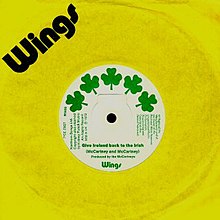| "Give Ireland Back to the Irish" | ||||
|---|---|---|---|---|
 | ||||
| Single by Wings | ||||
| B-side | "Give Ireland Back to the Irish (Version)" | |||
| Released | 18 February 1972 (UK) 28 February 1972 (USA) | |||
| Genre | Rock, protest song[1] | |||
| Length | 3:42 | |||
| Label | Apple | |||
| Songwriter(s) | Paul McCartney, Linda McCartney | |||
| Producer(s) | Paul McCartney | |||
| Wings singles chronology | ||||
| ||||
"Give Ireland Back to the Irish" is the debut single by the British–American rock band Wings that was released in February 1972. It was written by Paul McCartney and his wife Linda in response to the events of Bloody Sunday, on 30 January that year, when British troops in Northern Ireland shot dead thirteen civil rights protestors. Keen to voice their outrage at the killings, Wings recorded the track two days later at EMI Studios in London. It was the band's first song to include Northern Irish guitarist Henry McCullough.
"Give Ireland Back to the Irish" was banned from broadcast in the UK by the BBC and other organisations, and was overlooked by the majority of radio programmers in the United States. The single peaked at number 16 on the UK Singles Chart and number 21 on the US Billboard Hot 100, but topped the Irish Singles Chart for one week in March 1972.[2] Having never released an overtly political song before, McCartney was condemned by the British media for his seemingly pro-IRA stance on Northern Ireland.[3] As with Wings' then-recent album, Wild Life, the song was also maligned by many music critics.[4][5] These writers found McCartney's lyrics overly simplistic and viewed the single as an attempt by him to gain credibility for his new band on the back of a pressing political issue.
Wings performed "Give Ireland Back to the Irish" throughout their February 1972 tour of English and Welsh universities. The track first appeared on an album in 1993, when it was included as a bonus track on the CD reissue of Wild Life.
- ^ "The Story of Paul McCartney's 'Give Ireland Back to the Irish'". 19 February 2017.
- ^ "The Irish Charts - All there is to know". www.irishcharts.ie. Retrieved 7 July 2023.
- ^ Sounes 2010, pp. 294, 296.
- ^ Ingham 2003, pp. 127–28.
- ^ McGee 2003, p. 26.